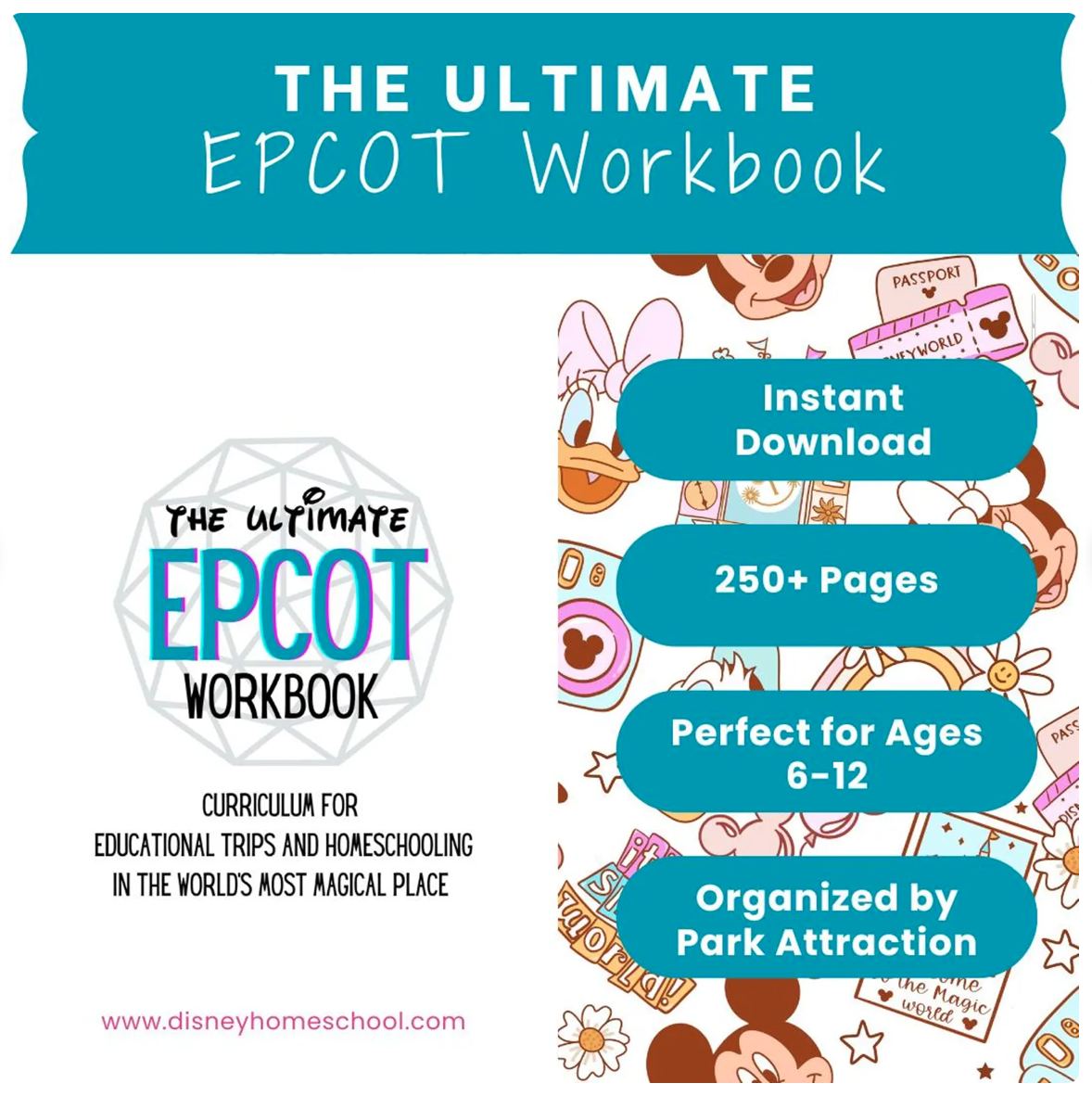Prepping for a Homeschool Day at EPCOT (Mexico Pavilion Edition) Ages 8-12
Homeschooling at Walt Disney World might sound like a dream, and in many ways, it is, but to make that dream educational, engaging, and enriching, it takes thoughtful planning and a bit of prep work. Our recent homeschool day focused on EPCOT’s Mexico Pavilion, and I want to share how I prepared for that adventure, what materials I used, and why I believe this kind of intentional educational trip creates long-lasting learning opportunities for kids ages 8–12.
Prepping for a Homeschool Day at EPCOT
Step by Step Guide to How I Plan Our Homeschool Days in the Parks
This was a special visit because the Grand Fiesta Tour Starring The Three Caballeros had just reopened. That gave us the perfect reason to center our lesson around Mexico, its ancient civilizations, geographical wonders, and rich folklore.
Step One: Planning Two Days Ahead with the Ultimate EPCOT Workbook
Two days before our park day, I pulled out my copy of the Ultimate EPCOT Workbook (available in my shop, link below). This printable curriculum is one of my go-to tools because I organized it by pavilion and attraction so it’s a quick grab for content. It contains over 250 pages of cross-curricular content in science, history, math, and language arts.
For this lesson, I chose:
The Mexico Language Lesson
The Ancient Civilizations Worksheet
The In-Park Mexico Activity Page
Each worksheet ties directly into Bloom’s Taxonomy, pushing my child to analyze, apply, and reflect, not just recall. It turns a day at the parks into something much deeper than sightseeing.
I print out the pages I need and move onto supplemental reading.
Step Two: Supporting Metacognition with a Free KWL Chart
Next, I print out a KWL sheet (Know, Want to Know, Learned). This free printable might seem simple, but it is one of the most powerful tools we use in our homeschool.
Why? Because it fosters metacognition, which is the process of thinking about how we think.
I believe metacognition is one of the most important goals in homeschooling, especially for ages 8–12, when kids are naturally curious and capable of developing their self-awareness. When we use a KWL chart, we are not just diving into a subject. We are giving space for our kids to identify their own learning gaps, set learning goals, and reflect afterward. This is how we move from passive learning to active engagement.
Our KWL chart for Mexico looked something like this:
K (Know): It’s in North America, Spanish language, Lots of ancient civilizations.
W (Want to know): Ancient and Current Culture
L (Learned): Day of the Dead is a day to honor the dead. It’s a big celebration. (This is completed after all of the lessons and used as reflection).
Step Three: Diving Into Books—History and Geography Come to Life
With our worksheets and KWL chart ready, it is time to prep content.
The first book I pull from our shelf is the Britannica Kids Encyclopedia (affiliate link by clicking image). This beautifully illustrated reference book gives just enough detail to spark questions and make meaningful connections without overwhelming younger readers. The sections on the Olmecs and Mayans are especially helpful for pairing with the EPCOT workbook's civilizations lesson. I use this book all the time for quick references or for delving into bigger subjects.
Next, I grab our DK Smithsonian Geography Visual Encyclopedia. Under the Mexico section, there is a spread on Mesoamerican caves, including cenotes, which are natural sinkholes that were sacred to the Mayans and also served as water sources. This is the perfect geographical bridge from history to science, and even works well into connecting our next book.
To build on that concept, I use our DK Eyewitness Wonders of the World book. Here we find a stunning spread on the Cave of Crystals (Naica Mine) in Chihuahua, Mexico, home to the largest natural crystals in the world. The book explains how the crystals formed in superheated water-filled caves over thousands of years.
What I love about this sequence is how naturally the conversation flows:
Who were the Mayans?
Where did they live?
How did they survive?
What did their environment look like?
Why were caves important to them?
Suddenly, we are not just talking about isolated facts. We are building an understanding of a civilization in context. This also what I love so much about homeschooling: it’s an organic conversation about learning and life. Yes, we use worksheets. But homeschooling is so much more behind the scenes!
Step Four: Incorporating Storytelling and Literature
To bring in a literacy component, I use the book A Year Full of Stories by Angela McAllister (affiliate link below). Each month includes a folk tale from a different part of the world. For our Mexico lesson, we read the Mayan tale of the Rabbit and the Crab.
After learning about the climate, terrain, and mythology of the Mayans, my child was able to ask deep, reflective questions:
Who was the trickster and why?
What does the story mention about what you have learned so far?
What might this story have taught Mayan children and why do you think it was told?
This is where homeschooling shines. We are not just checking off boxes for language arts or reading comprehension. We are analyzing symbolism, questioning purpose, and connecting across disciplines.
Step Five: Packing Our Materials and Heading Into EPCOT
With our KWL chart, printed worksheets from the Ultimate EPCOT Workbook, and a fresh perspective on Mexico’s geography and civilizations, we are ready to go.
The pre-park Mexico activity includes:
Language Acquisition: A mini language lesson that encourages them to say and write words in Spanish
A mini research guided activity into the ancient civilizations
The in-park activities include tying in everything we have learned with content from the park.
We pack the in park worksheet and tuck it into our park bag alongside a pencils and maybe a clipboard. While waiting in line or sitting for a snack, we reflect. Then we use what we learned as we ride the Grand Fiesta Tour, watch the animatronic Donald, José, and Panchito, and examine the Pavilion’s murals, marketplace, and Aztec-inspired artifacts.
Final Thoughts: Why We Do It
The Mexico Pavilion offers a truly rich and layered opportunity for homeschool families. From caves to civilizations, from crystal formations to cultural folktales, the threads of this unit come together to create a meaningful, interdisciplinary experience.
When we homeschool at Walt Disney World, it is not about forcing learning into vacation. It is about recognizing the educational value that is already there and building on it intentionally.
With a bit of prep and the right tools, including the Ultimate EPCOT Workbook, a KWL chart, and a few quality reference books, your homeschool day at EPCOT can go beyond fun. It becomes a day of discovery, connection, and deep learning that your child will remember long after they leave the park.












